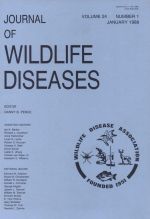Organophosphorous and carbamate pesticides are potent anticholinesterase substances that have killed large numbers of wild birds of various species. Cause of death is diagnosed by demonstration of depressed brain cholinesterase (ChE) activity in combination with chemical detection of anticholinesterase residue in the affected specimen. ChE depression is determined by comparison of the affected specimen to normal ChE activity for a sample of control specimens of the same species, but timely procurement of controls is not always possible. Therefore, a reference file of normal whole brain ChE activity is provided for 48 species of wild birds from North America representing 11 orders and 23 families for use as emergency substitutes in diagnosis of anticholinesterase poisoning. The ChE values, based on 83 sets of wild control specimens from across the United States, are reproducible provided the described procedures are duplicated. Overall, whole brain ChE activity varied nearly three-fold among the 48 species represented, but it was usually similar for closely related species. However, some species were statistically separable in most families and some species of the same genus differed as much as 50%.
How to translate text using browser tools
1 January 1988
BRAIN CHOLINESTERASE ACTIVITY OF APPARENTLY NORMAL WILD BIRDS
Elwood F. Hill

Journal of Wildlife Diseases
Vol. 24 • No. 1
January 1988
Vol. 24 • No. 1
January 1988
anticholinesterase poisoning
brain cholinesterase activity
carbamate pesticide
diagnostic methodology
normal values
organic phosphorus pesticide
toxicology




